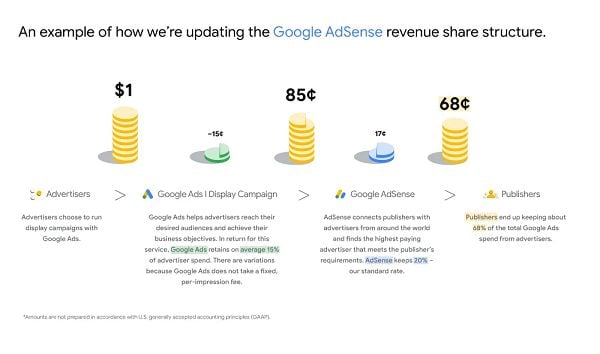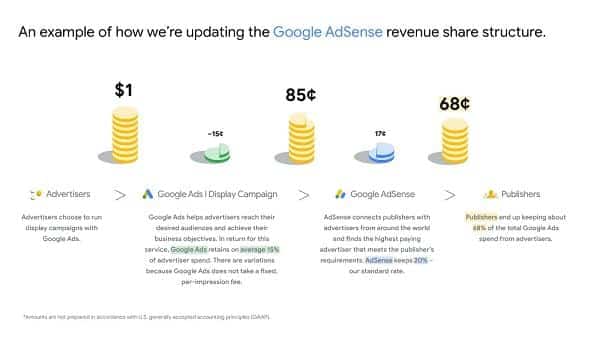Google has announced that it’s updating its AdSense payment structure, which will now see it pay publishers by impression, as opposed to a flat-fee share structure for AdSense revenue share.
Which could have an impact on website ad revenue share, though Google says that most websites will see no impact. And it’s impossible to know till it’s implemented either way.
As explained by Google
“For years, AdSense has been transparent about the fee we charge for our service, which is consistent with industry rates. When publishers have chosen to use AdSense to monetize their content, they have kept 68% of the revenue. Previously, the Google AdSense network processed fees within a single transaction. We are now splitting the AdSense revenue share into separate rates for the buy-side and sell-side. For displaying ads with AdSense for content, publishers will receive 80% of the revenue after the advertiser platform takes its fee, whether that be Google’s buy-side or third-party platforms.”

So essentially, Google’s splitting the fee structure, which should result in most websites still getting about the same revenue share. But that amount will vary, dependent on the ad campaign and its aims, etc.
It seems like more of a change to improve Google’s own tracking and display systems, but in some instances, it will also net Google a bigger share of ad revenue. Which, at Google’s scale, is likely significant, but for regular advertisers, the impact, Google says, will be minimal.
In addition to this, AdSense will soon transition from paying publishers per click, to paying per impression.
“This update will provide a more uniform way for paying publishers for their ad space across Google’s products and third-party platforms, helping them compare with other technology providers they use.”
This one will definitely generate more revenue for the Big G, and it’ll be interesting to see how the change will impact publisher payouts, by lowering the threshold for ad delivery. It could also see more advertisers re-assessing their Google campaigns, as they’ll have to pay for lesser engagement, as opposed to more overt action taken as a result.
Still, Google says that the update will not alter the type or quantity of ads that publishers can display on their websites, and again, it expects payment impacts to be minor, if anything.
We’ll soon find out.
Google says that both updates will go into effect early next year.



